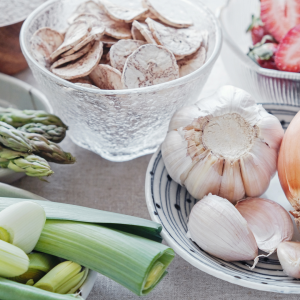The Garden Growing In Your Belly
And it’s not from that watermelon seed you swallowed!
Last month we talked about taking good care of your gut microbes to keep them in beneficial balance, and one way to really nourish them and keep them quite happy is by feeding them well. Think of these beneficial microbes as the flowers in your garden, while prebiotics serve as the fertilizer to enrich the garden soil and help the flowers to thrive.

The beneficial microbes that support great mood, balance the immune system, and nourish our gut lining really enjoy eating plant foods (and this is why I am concerned about opting for long stretches on diets such as Carnivore, where there are no plant foods to feed these beneficial bugs. No food? These anti-inflammatory microbes die out, and more inflammation-promoting microbes thrive on the excessive protein being consumed).
The parts of the plant-based foods that are especially beneficial are carbohydrates, and not just any will do. We are looking specifically at fiber, as well as special sugars called oligosaccharides. To our microbes, these are a feast! They take these foods and generate tons of anti-inflammatory compounds (short chain fatty acids, or SCFAs) that help prevent colon cancer and support nutrient absorption. SCFAs also circulate our entire body, helping to regulate blood sugar, appetite, mood, kidneys, and immune system (and thus, allergies and eczema), provide a source of energy, and heal our gut cells.
Note that not all fibrous foods contain prebiotics. We need to be diligent here, but you’ll see you probably already get some of these prebiotics in your regular diet!
So where do we find these gut-friendly superfoods? Here’s my top list of foods to choose within your weekly menu!
- Onions, garlic, leeks, chives, scallions, shallots, etc.
- Jerusalem artichokes
- Asparagus
- Dandelion greens
- Jicama
- Chicory
- Glucomannan, or konjac (Miracle Noodles)
- Nectarines, pears
- Raspberries
- Watermelon
- Greener bananas and plantains
- Beans (especially chickpeas), lentils
- Apples with peel
- Whole grain wheat (if tolerated)
- Organic raw lactose-containing dairy: milk, cream, butter, yogurt, cheese (if tolerated) – and nope, not a fibrous plant! It’s the exception here, providing us with galacto-oligosaccharides from the lactose.

Sometimes we also supplement prebiotics to give an extra boost. Some of my favorite products include Sunfiber (partially hydrolyzed guar gum), Microbiome Labs MegaPre, Klaire Galactomune, and Jarrow Prebiotic XOS+alpha-GOS. (You can purchase these here).
Resistant starches are another category of prebiotic foods that are acted upon by your beneficial bacteria. Top resistant starches include:
- greener bananas and plantains, raw banana flour
- cooked and cooled beans, peas, lentils, rice, and potatoes
- raw potato starch; and whole grains including gluten
I can’t emphasize this enough: If prebiotics are not a regular part of your diet, it is VERY important to introduce them slowly. S-L-O-W-L-Y. As the microbes shift or find themselves with a new abundance of food, they will get extremely happy and eat, eat, eat! And as a result, you may find yourself a bit…gassy. Hopefully not to the point of discomfort, but too much too fast could lead to excessive feelings of unwell. This is normal and will decrease over time. And this is especially true for supplemental prebiotics, since the dosage is so much higher than from food alone.
I suggest aiming for at least 29 g dietary fiber per day, plus a focus on getting at least 1-2 prebiotic foods in per day. Supplement if needed. This will help your probiotic bacterial community to thrive and bestow their benefits. After all, give and you shall receive – when you support your microbes’ growth and vitality, they return the favor in immeasurable ways.
